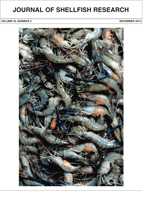Subtidal oyster (Crassostrea virginica) reefs constructed during in the mid 1990s in Pamlico Sound, North Carolina, initially supported high densities of oysters; however, beginning around 2007, oyster density subsequently declined. Concurrent with the decline in oyster density was an increase in the prevalence of boring sponges (Cliona) on oysters and the underlying reef substrate material at these sites. The limestone marl substrate used to build these reefs became colonized by boring sponge to the degree that bioerosion by sponge potentially compromised the suitability of the reefs for oysters. Laboratory and field experiments were conducted to determine whether oyster demographic rates of settlement, recruitment, growth, and mortality were affected by the presence of Cliona on underlying shell substrate. Oyster settlement on shells with varying levels of sponge was measured in the laboratory, and oyster recruitment, growth, and mortality in the presence and absence of sponge were measured in 2 estuaries in coastal North Carolina from 2011 to 2012. Potential alternative substrates for future reef restoration were tested in the field to determine their susceptibility to bioerosion by sponges. Substrates included 2 composed of calcium carbonate (CaCO3; oyster shells and limestone marl) and 2 non-CaCO3 substrates (concrete and granite), because bioerosion by clionids target CaCO3. Surprisingly, no differences in oyster settlement, recruitment, growth, or mortality in the presence versus absence of Cliona were observed, suggesting that effects of the presence of sponge on oysters are either chronic rather than acute or are indirect and must act in concert with other oyster enemies. Notable patterns of sponge growth on the alternate substrates emerged; oyster shells were most susceptible to sponge growth, followed by marl, whereas concrete and granite were not susceptible to colonization by Cliona. Results from this study demonstrate the importance of having a strong understanding of the specific restoration methodology to be implemented, because the susceptibility of a substrate to bioerosion could have serious implications for reef longevity. Evidence is presented that consideration of the broader estuarine environment, including both biotic and abiotic factors, is vital when planning restoration actions, because the presence of Cliona was less important than the estuarine salinity gradient in altering oyster demographic rates and may shift the trajectories of restored reefs.
How to translate text using browser tools
1 November 2014
Oyster-Sponge Interactions and Bioerosion of Reef-Building Substrate Materials: Implications for Oyster Restoration
Robert P. Dunn,
David B. Eggleston,
Niels Lindquist
ACCESS THE FULL ARTICLE

Journal of Shellfish Research
Vol. 33 • No. 3
November 2014
Vol. 33 • No. 3
November 2014
bioerosion
clionid sponge
Crassostrea virginica
growth
mortality
oyster
recruitment




